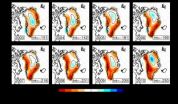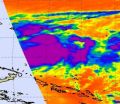(Press-News.org) LEXINGTON, Ky. (Nov. 27, 2012) -- Digoxin, a drug widely used to treat heart disease, increases the possibility of death when used by patients with a common heart rhythm problem − atrial fibrillation (AF), according to new study findings by University of Kentucky researchers. The results have been published in the prestigious European Heart Journal, and raises serious concerns about the expansive use of this long-standing heart medication in patients with AF.
UK researchers led by Dr. Samy Claude Elayi, associate professor of medicine at UK HealthCare's Gill Heart Institute, analyzed data from 4,060 AF patients enrolled in the landmark Atrial Fibrillation Follow-up Investigation of Rhythm Management (AFFIRM) trial. This analysis was intended to determine the relationship between digoxin and deaths in this group of patients with atrial fibrillation, and whether digoxin was directly responsible for some deaths.
"These findings raise important concerns about the safety of digoxin, one of the oldest and most controversial heart drugs," said Dr. Steven E. Nissen, chair of cardiovascular medicine at the Cleveland Clinic. "Although considered obsolete by some authorities, digoxin is still widely used. A thorough review by the FDA is warranted to determine whether regulatory action is needed, including stronger warnings about the use of digoxin in patients with atrial fibrillation. "
Digoxin is extracted from the foxglove plant and it helps the heart beat more strongly, and at a slower heart rate. It is commonly used in AF patients and in patients with heart failure. However, it can be problematic to use successfully as there is a narrow dose range at which it is effective, and beyond which it can be dangerous.
Though digoxin has been used by physicians treating AF for decades, until now, there has been limited evidence demonstrating the effect of digoxin in patients with this condition. "Digoxin in AF patients has hardly been studied," said Elayi. "The main prospective randomised controlled trials available with digoxin were performed in patients with heart failure and sinus rhythm, and routinely excluded AF patients."
The results of the analysis found that digoxin was associated with a 41 percent increase in deaths from any cause after controlling for other medications and risk factors. An increase in deaths occurred regardless of gender or the presence or absence of underlying heart failure. Digoxin was also associated with a 35 percent increase in deaths from cardiovascular causes, and a 61 percent increase in deaths from arrhythmias or problems with the rate or rhythm of the heartbeat.
"Within five years of use, one additional AF patient out of six taking digoxin − compared to those not on digoxin in the AFFIRM trial− will die from any cause," Elayi said. "One additional patient out of eight will die from cardiovascular causes, and one additional patient out of 16 will die from arrhythmias.
"This study calls into question the widespread use of digoxin in patients with AF, particularly when used for controlling AF rate in a similar way as in the AFFIRM trial," Elayi said. "These findings suggest that physicians should try to control a patient's heart rate by using alternatives such as beta-blockers or calcium blockers ,as a first line treatment.
"If digoxin is used, prescribers should use a low dose with careful clinical follow up, evaluate potential drug interactions when starting new medications, and monitor digoxin levels."
In addition, patients should also be aware of potential toxicity and see their physicians immediately in specific clinical situations, he said. For instance, if they experience increasing nausea, vomiting, palpitations or syncope, as those may precede arrhythmic death, Elayi added.
The researchers say that the mechanism by which digoxin increases deaths among patients is unclear. Deaths from classic cardiovascular causes - whether or not they are due to arrhythmia - can partly but not entirely explain it. This suggests there must be some additional mechanism that remains to be identified, said Elayi.
"Our study underscores the importance of reassessing the role of digoxin in the contemporary management of AF in patients with or without HF," concluded the authors in their paper.
"There is a need for further studies of the drug's use, particularly in systolic heart failure patients and AF – patients that would, in theory, benefit the most from digoxin."
INFORMATION:
Media Contact: Jodi Whitaker at (859) 257-5307
END
LA JOLLA, CA – November 27, 2012 – Researchers at The Scripps Research Institute (TRSI) are fueling the future of cancer treatment by improving a powerful tool in disease defense: the body's immune system. By revealing a novel but widespread cell signaling process, the scientists may have found a way to manipulate an important component of the immune system into more effectively fighting disease.
The study, recently published online ahead of print by the journal Blood, shows that disabling a particular enzyme, called ItpkB, in mice improves the function of a type of immune ...
By using common materials found pretty much anywhere there is dirt, a team of Michigan State University researchers have developed a new thermoelectric material.
This is important, they said, because the vast majority of heat that is generated from, for example, a car engine, is lost through the tail pipe. It's the thermoelectric material's job to take that heat and turn it into something useful, like electricity.
The researchers, led by Donald Morelli, a professor of chemical engineering and materials science, developed the material based on natural minerals known ...
VIDEO:
Princeton University researchers developed an enhanced approach to capturing changes on the Earth's surface via satellite that could provide a more accurate account of how geographic areas change as a...
Click here for more information.
An enhanced approach to capturing changes on the Earth's surface via satellite could provide a more accurate account of how ice sheets, river basins and other geographic areas are changing as a result of natural and human factors. ...
Toronto, ON (27 November, 2012) -- A new method of growing cardiac tissue is teaching old stem cells new tricks. The discovery, which transforms aged stem cells into cells that function like much younger ones, may one day enable scientists to grow cardiac patches for damaged or diseased hearts from a patient's own stem cells—no matter what age the patient—while avoiding the threat of rejection.
Stem cell therapies involving donated bone marrow stem cells run the risk of patient rejection in a portion of the population, argues Milica Radisic, Canada Research Chair in ...
Parents may have some new motivations to serve their kids vegetables. A new Cornell University study, published in Public Health Nutrition, found that by simply serving vegetables with dinner, the main course would taste better and the preparer was perceived to be more thoughtful and attentive.
"Most parents know that vegetables are healthy, yet vegetables are served at only 23% of American dinners," said lead author Brian Wansink, PhD, the John Dyson Professor of Marketing and Consumer Behavior at Cornell University. "If parents knew that adding vegetables to the plate ...
Boulder, Colo., USA – GSA Bulletin articles posted online between 2 October and 21 November span locations such as the San Andreas fault, California; Tibet; Mongolia; Maine; the Owyhee River, Oregon; the Afar Rift, Ethiopia; Wyoming; Argentina; the Sinai Peninsula, Egypt; British Columbia; the southern Rocky Mountains; Scandinavia; and Saturn's largest moon, Titan. Topics include the "big crisis" in the history of life on Earth; the structural geology of Mount St. Helens; and the evolution of a piggyback basin.
GSA Bulletin articles published ahead of print are online ...
A NASA study using TRMM satellite data revealed that the year 2010 was a particularly bad year for landslides around the world.
A recent NASA study published in the October issue of the Journal of Hydrometeorology compared satellite rain data from NASA's Tropical Rainfall Measurement Mission (TRMM) to landslides in central eastern China, Central America and the Himalayan Arc, three regions with diverse climates and topography where rainfall-triggered landslides are frequent and destructive hazards to the local populations.
The work, led by Dalia Kirschbaum, a research ...
It's a digital world. Or is it?
NASA technologist Jonathan Pellish isn't convinced. In fact, he believes a computing technology of yesteryear could potentially revolutionize everything from autonomous rendezvous and docking to remotely correcting wavefront errors on large, deployable space telescope mirrors like those to fly on the James Webb Space Telescope.
"It's fast forward to the past," Pellish said, referring to an emerging processing technology developed by a Cambridge, Mass.-based company, Analog Devices Lyric Labs.
So convinced is he of its potential, Pellish ...
Tropical storm warnings are in effect in Micronesia as NASA and other satellite imagery indicates that Tropical Storm Bopha continues to intensify.
The Atmospheric Infrared Sounder (AIRS) instrument that flies aboard NASA's Aqua satellite captured an infrared image of Tropical Storm Bopha on Nov. 27 at 0241 UTC that indicated a lot of power exists in the strengthening tropical storm. The AIRS image captured the eastern half of the tropical storm and showed a large area of very cold, very high cloud tops, where temperatures colder than -63 Fahrenheit (-52 Celsius) have ...
CHICAGO – New magnetic resonance imaging (MRI) research shows that mountain climbers who experience a certain type of high altitude sickness have traces of bleeding in the brain years after the initial incident, according to a study presented today at the annual meeting of the Radiological Society of North America (RSNA).
High altitude cerebral edema (HACE) is a severe and often fatal condition that can affect mountain climbers, hikers, skiers and travelers at high altitudes—typically above 7,000 feet, or 2,300 meters.
HACE results from swelling of brain tissue due ...








